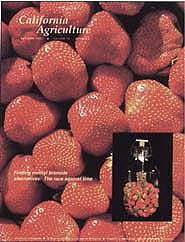All Issues

Finding methyl bromide alternatives: The race against time
Cover:
Methyl bromide has contributed to the success of California's vital strawberry industry. However, the fumigant is scheduled to be phased out for most uses in 2005 due to impacts on the ozone layer. UC scientists are searching for viable alternatives. For example, UC Davis researcher Elizabeth Mitcham is experimenting with new methods of postharvest fumigation, to control insects and mites in exports. In a promising study, inset , strawberries are exposed to various concentrations of carbon dioxide and acetaldehyde, a natural compund produced by the fruit. Cover photo by Phil Schermeister. Inset photo by Don Edwards .
May-June 2001
Volume 55, Number 3
Volume 55, Number 3





